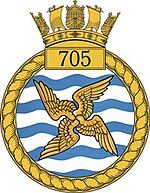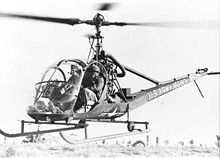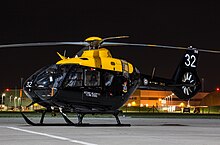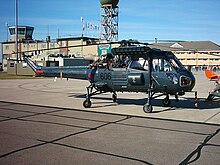
The Fleet Air Arm (FAA) is the naval aviation component of the United Kingdom's Royal Navy (RN). The FAA is one of five RN fighting arms. As of 2023 it is a primarily helicopter force, undertaking roles once performed by biplanes such as the Fairey Swordfish. It operates the F-35 Lightning II for maritime strike and the AW159 Wildcat and AW101 Merlin for commando and anti-submarine warfare.

Royal Air Force Shawbury, otherwise known as RAF Shawbury, is a Royal Air Force station near the village of Shawbury in Shropshire in the West Midlands of England.
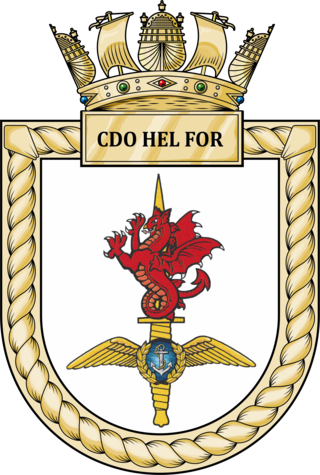
Commando Helicopter Force (CHF) is a unit of the Royal Navy Fleet Air Arm and an element of the Joint Aviation Command of the British Armed Forces. Its primary role is to provide Rotary-Wing support to 3 Commando Brigade Royal Marines and other UK force elements in the amphibious environment. CHF uses a combination of transport helicopters based at Royal Naval Air Station Yeovilton in Somerset, England.

The Defence Helicopter Flying School (DHFS) was a military flying school based at RAF Shawbury in Shropshire, England. The school, established in 1997, was a tri-service organisation and trained helicopter aircrews for all three British armed forces. It initially used the Eurocopter Squirrel HT1 and Bell Griffin HT1 helicopters, which were retained despite the introduction of the Airbus Juno HT1 and Airbus Jupiter HT1.

The Central Flying School (CFS) is the Royal Air Force's primary institution for the training of military flying instructors. Established in 1912 at the Upavon Aerodrome, it is the longest existing flying training school. The school was based at RAF Little Rissington from 1946 to 1976. Its motto is Imprimis Praecepta, Latin for "The Teaching is Everlasting".
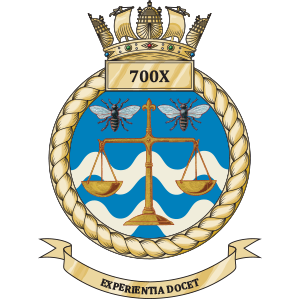
700 Naval Air Squadron is an experimental test squadron in the Royal Navy’s Fleet Air Arm.

848 Naval Air Squadron was a squadron of the Royal Navy Fleet Air Arm. It operated the Westland Sea King HC.4 helicopter and previously provided advanced flying training to pilots for the other squadrons in the Commando Helicopter Force. The squadron was based at RNAS Yeovilton in Somerset and was decommissioned on 24 March 2016.
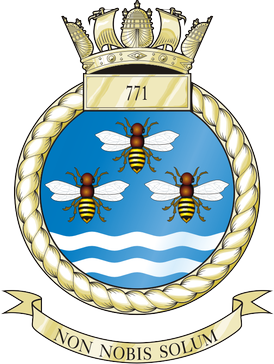
771 Naval Air Squadron of the Fleet Air Arm was formed on 24 May 1939 at HMS Daedalus, Lee-on-Solent as a Fleet Requirements Unit with 14 Fairey Swordfish TSR biplanes. The squadron carried out various exercises with ships and provided towed targets for naval air gunners, and was decommissioned on 22 March 2016.

727 Naval Air Squadron is a squadron of the Royal Navy Fleet Air Arm. It was formed in 1943 as a Fleet Requirements Unit, being disbanded in December 1944. It was reformed twice in the 1940s and 1950s to provide flying experience for naval officers. The current squadron was created on 6 Dec 2001 from the Royal Naval Flying Training Flight. It operates the Grob Tutor, with its primary role to provide grading and legacy-Elementary Flying Training for Royal Navy and Royal Marine pilots under training. It also supports the Royal Navy's "Flying Start" flying scholarship scheme.

815 Naval Air Squadron is a Royal Navy Fleet Air Arm squadron flying the AgustaWestland Wildcat HMA.2 helicopter and is the Navy's front line Wildcat Naval Air Squadron. The squadron is based at RNAS Yeovilton in Somerset. The squadron is capable of carrying out multiple roles such as: counter-narcotics, anti-piracy, Above Surface Warfare (ASuW), search and rescue, disaster relief and flying and engineering training. In the early 2000s, the Navy said that the squadron was largest helicopter squadron in Europe.
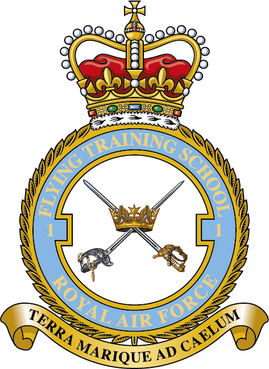
The No. 1 Flying Training School is the oldest military pilot training school in the world, currently used to deliver rotary training to aircrew of the British armed forces.
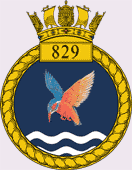
829 Naval Air Squadron was a squadron of the Royal Navy Fleet Air Arm. Before it was decommissioned in March 2018, it operated the AgustaWestland Merlin HM2 helicopter.

701 Naval Air Squadron was a Royal Navy Fleet Air Arm squadron, which last disbanded during September 1958 at RNAS Lee-on-Solent where it was a Helicopter Trials, Communications and Fleet Requirements Unit. It initially formed during July 1936 as a Catapult Flight operating out of Malta and routinely embarking in RN ships such as, HMS Barham, HMS Malaya, HMS Valiant and HMS Warspite. By autumn 1939 it was known as 701 Naval Air Squadron but disbanded in January 1940. It was active twice more during the Second World War, between May 1940 and June 1941 on special duties and then between October 1942 and August 1943 performing anti-submarine patrols. Reforming in April 1945 it was designated a Communications Unit, operating out of Heston until disbanding in 1947. It last reformed as a Fleet Requirements Unit at HMS Daedalus, Lee-on-Solent, during October 1957.
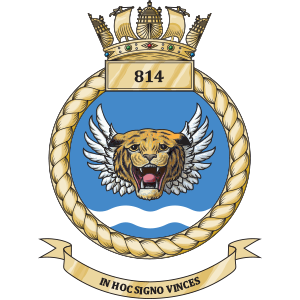
814 Naval Air Squadron or 814 NAS, nicknamed the Flying Tigers, is a squadron of the Royal Navy Fleet Air Arm. It is currently equipped with the AgustaWestland Merlin HM2 anti-submarine warfare helicopter and is based at Royal Naval Air Station (RNAS) Culdrose in Cornwall. The squadron was formed in December 1938 and has been disbanded and reformed several times.

703 Naval Air Squadron of the Fleet Air Arm of the Royal Navy was formed as a long-range catapult squadron on 3 March 1942 at RNAS Lee-on-Solent. During the Cold War, it was reformed as an experimental trials unit, and then as a helicopter training squadron. Since 2003, the squadron has formed the Royal Naval wing of the Defence Elementary Flying Training School at RAF Barkston Heath.

737 Naval Air Squadron was a Naval Air Squadron of the Royal Navy's Fleet Air Arm. It was initially active during 1943 as an amphibious Bomber Reconnaissance Training Squadron. Reactivated in 1944 it operated as an ASV Training Unit until 1945. It was active again between 1949 and 1957. From 1959 it was the Anti-Submarine Warfare school at RNAS Portland. It operated Westland Wessex HAS.3 rescue helicopters from their land base at RNAS Portland, Dorset.
The History of Royal Navy Helicopter Search and Rescue has its roots in the adoption by the Royal Navy of helicopters in the plane guard role. From a purely military tasking Royal Navy squadrons came to share the provision of search and rescue SAR coverage for the United Kingdom with the Royal Air Force and commercial providers under contract to Her Majesty's Coastguard, being responsible for two sectors out of twelve. From 2015 both the RAF and the Navy will surrender the civilian SAR role to contractors operating on behalf of the Coastguard.

707 Naval Air Squadron was a Naval Air Squadron of the Royal Navy's Fleet Air Arm which disbanded during February 1995. It was active during the Second World War forming during February 1945 as a Radar Trials Unit, disbanding in October of the same year. It reformed December 1964, as an Advanced and Operational Flying Training Commando helicopter squadron.

772 Naval Air Squadron was a Naval Air Squadron of the Royal Navy's Fleet Air Arm which last disbanded during September 1995. 772 Naval Air Squadron formed as a Fleet Requirements Unit out of ‘Y’ Flight from 771 Naval Air Squadron at RNAS Lee-on-Solent in September 1939. While the headquarters remained there, floatplanes were operated out of RNAS Portland, however, mid 1940 saw the whole squadron move north to RNAS Campbeltown and roughly twelve months afterwards the short distance to RNAS Machrihanish. The unit moved to RNAS Ayr in July 1944 and became the Fleet Requirements Unit School. In January 1946 the squadron moved to RNAS Burscough in Lancashire, before moving to RNAS Anthorn in Cumberland, in May. It became the Northern Fleet Requirements Unit upon moving to RNAS Arbroath, in June 1947, but disbanded into 771 Naval Air Squadron in October. 772 Naval Air Squadron reformed as a Helicopter Support Squadron at RNAS Portland in September 1974. In September 1977 the squadron took over responsibility for a number of Ships' Flights of Royal Fleet Auxiliary ships. The squadron was used to reform 848 Naval Air Squadron for the Falklands Task Force in 1982, with the Ships' Flights absorbed into 847 Naval Air Squadron. In August 1982 it took on the Anti-Submarine Warfare Flight from 737 Naval Air Squadron and between 1983 - 1985 a Search and Rescue Flight operated out of RNAS Lee-on-Solent.
